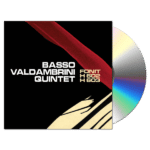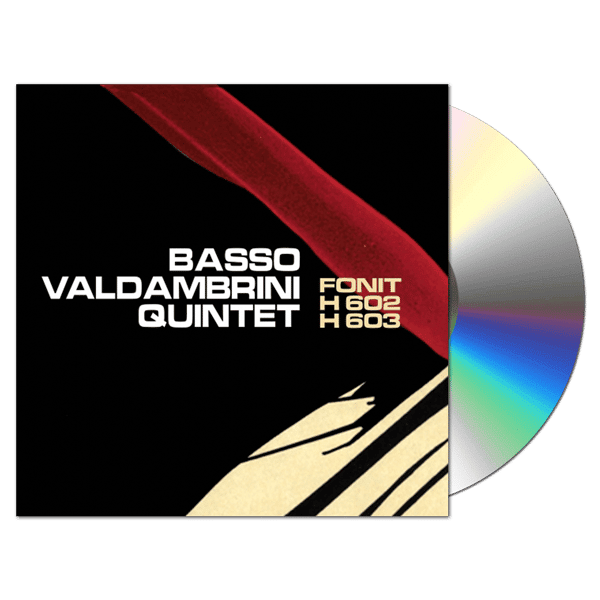Two obscure albums by Basso Valdambrini Quintet originally released for TV and Radio Shows on Usignolo Series by Fonit Cetra. Now available for the Basso-Valdambrini’s lovers.
* * *
Two Records and a Market
We might shout “Long live CD!” when we look at the reissue you hold in your hands. But donʼt forget that the staff of Schema Records have also generously provided us with a vinyl version. “Long live CD!” might sound odd at a time when the age of the CD seems to be all but over. Yet the compact disc remains the most democratic format: not as elitist as the beautiful old 33 rpm record, which today is unfortunately absent from many home hi-fi systems – and above all, not as ephemeral as the digital download format that seems so much in fashion today. To some listeners the phonograph record is still important: itʼs associated with care, attention, concentration. Like going to the cinema, compared to watching a movie on the screen of a PC, another habit particularly in vogue today. Is it really comparable to walking into a cinema, switching off the mobile and being captivated by a story, as you empathise or identify yourself with an actor? Yes, the same is true of listening to music, whether youʼre a fanatic or a casual devotee: reverently handling the record case, admiring the packaging, browsing the booklet and probing the details of archive photos… and maybe reading these few introductory notes. These are all aspects that, even if they canʼt equal the experience of listening, can surely enrich it. At least for the help they provide in putting the listener in the right frame of mind. The iPod is definitely a beautiful thing, but perhaps is most suited to being attached to joggersʼarms. Here, the choice is up to you: Schema Records has made these recordings available both as utilitarian CDs and beguiling vinyl.
Why this sociological introduction for the reissues of two Italian jazz records of the early seventies? Because fate decided that these recordings of the Gianni Basso and Oscar Valdambrini Quintet (cryptically entitled H602 and H603 respectively) were born under a bad sign and were to be considered second-class recordings by music professionals, and sometimes by the musicians themselves. Fading into oblivion and unappreciated, these records then reappeared as objects of worship, highly sought-after by avid collectors. Desired, exchanged or sold for astronomical sums. In fact, these two discs by the “Basso-Valdambrini Quintet” – the name by which one of the longest lived and most prolific Italian jazz combos was known to aficionados – originated as library music. A humble term, but one that indicates music recorded to accompany radio and later television shows, to act as jingles or simply provide musical interludes. They all date from December 1970. These records had no commercial release and werenʼt available in stores. That’s one of the reasons why they were viewed with some disdain. Yet they were important for allowing musicians to earn a living, especially among what Franco D’Andrea, remembering his early years, calls «the first [Italian] generation to realise, despite all the obstacles, that being a Jazz musician could be a profession». And even more, these records were a way to spread Jazz beyond the small Jazz clubs and to ensure that, while hardly realising it, more people became acquainted with this music. It reached a wide audience as a background for various forms of popular entertainment.
When those recordings came out, the Gianni Basso and Oscar Valdambrini Quintet had already released other LPs in fifteen years of intense activity (the ensemble split up shortly afterwards). It was a group that – even with a frequently changing rhythm section, in which Ettore Righello and Renato Sellani alternated at the piano and Lionello Bionda and Gil Cuppini took turns behind the drums, not to mention some occasions in which the quintet morphed into sextet, with the addition of Dino Pianaʼs trombone – enjoyed a considerable international reputation. In these two LPs from the Usignolo series one can definitely hear a band at its peak, their music achieved through empathy and common feeling rather than just pursuit of commercial success. The improvisations are always stimulating, as well as the variety of the repertoire on offer. The latter could have easily been opportunistically chosen, considering the underlying utilitarian purpose of library music, but instead it offers strong evidence of the bandʼs expressive power. Looking at the original pressings, the simple graphic design of their covers and the utter lack of information stimulates intense curiosity. Each piece of music was simply given a caption, describing it in terms of classical music and providing practical guidance for whoever – the director or programmer – had to select the music. We will never know exactly what radio programs accompanied “Mick” or “Valba” but it certainly inspires the imagination to read alongside these titles descriptions such as «modern, incisive theme» or «nervous and snappy Allegro». Or even more «very modern Moderato featuring new Jazz experiences» for “Maglione”. Or, «Moderato with references to Mulliganʼs style. Meditative theme…» the bold description of “Gum”.“Glaucus” on the other hand is described as: «Moderato mosso. Very interesting, especially for the bold conception of the melody». Of course these naïve descriptions could raise a smile, but we should listen to the music while bearing in mind the pompous institutional reality of RAI (Italyʼs national public radio broadcaster). Perhaps now, more than ever, when scores are produced with computers, we can feel a sense of truthfulness and artistry even in these seemingly disconnected fragments. Not to mention that these records were in no way inferior to their counterparts, the LPs which were officially available on the market. Franco D’Andrea recalls his experience as pianist of the band leaded by Enzo Scoppa and Cicci Santucci, saying without hesitation that «the soundtrack recordings that we carried out, what we used to call library music, and which we considered no more than a warm up for our ʻofficialʼ recordings for the marketplace, turned out to be much more interesting than the latter».
The marketplace indeed. There are interesting aspects to the relationship between these recordings and the market. Let’s start from the beginning: the Usignolo series was specially set up by Fonit Cetra for commercial reasons. Or, to be more accurate, opportunism. Fonit Cetra at the time was a powerful record label with a considerable market penetration across several music genres. But even more, it was intimately linked to RAI in its ownership structure. And RAI, at least till the mid seventies, remained the sole beneficiary of music scores. This prevented Fonit realising its full potential, since releasing all his recordings on RAI programs infringed the customs and rules of fair competition against other independent labels of that time. Horo above all. In a classic Italian manner, a loophole was found: the records came out under the brand ʻSerie Usignoloʼ and Fonit could take full advantage of its alliance with RAI. Not a particularly well kept secret, perhaps, but it served well enough through the years.
And what about the musicians? Was there any struggle to put together these recording sessions? «Not much», recalls Adriano Mazzoletti, a living encyclopaedia of the world of radio. «On one hand, these seemed to many to be second class recordings. But on the other, we must consider that at that time there were not so many instrumentalists at ease with the forms of modern Jazz. At least for the kind of music produced for use on TV and radio shows». Mazzoletti continues: «These were recordings carried out in Rome and Milan – the haunts of Valdambrini and Basso – and in both cities there was a RAI orchestra». It was from their ranks that the most gifted jazz players were chosen. Furthermore, this was incredibly convenient: since these musicians were working at RAI, they could not receive any royalties for any of their compositions included in the soundtracks. Royalties were to be considered part of the salary of the orchestral performance. This explaining the slightly altered names associated with the compositions. This was common practise, although from research carried out for the three discs here, the authorship of the songs has been established with a fair degree of certainty.
These records have always been caught up with the market and its logic, although in an unorthodox way. Even more interesting is the new relationship they developed with the market long after their initial releases, when those few rare original copies were distributed. Perhaps because of the appeal that Italian and Easy Listening Jazz of the sixties and seventies had begun to exert on the Japanese market first, and then on the American one, those copies became sought after collectorʼs items. Originally intended as vehicles of musical mass communication, the recordings became collector’s fetishes enjoyed by a small and often fanatical minority of people, a sharply ironic reversal of their nature. On the Internet – that whimsical and changeable medium – prices have soared: a copy of H603 has sold for over $400. The collector market is a parallel reality based on a simple financial logic, but also driven by the emotions of the collectors. And it is not difficult to come across collectors who are moved by the possession of the rarity rather than its actual artistic content, and are likely to treat records as some sort of relic on their shelves, with a small label on the plastic cover indicating price and conditions of the LP and of the sleeve. But when one goes to talk with them, hoping to hear something new and rare, the answer is often «Well, you know… if I play the record, the needle could damage it a little, halving its value». Discouraging. But today a whole new chapter begins in the long history of these two outstanding records: now for the first time they will be easy to find, available for sale to the public and – crucially – at an affordable price. Happy listening.
Andrea Di Gennaro




